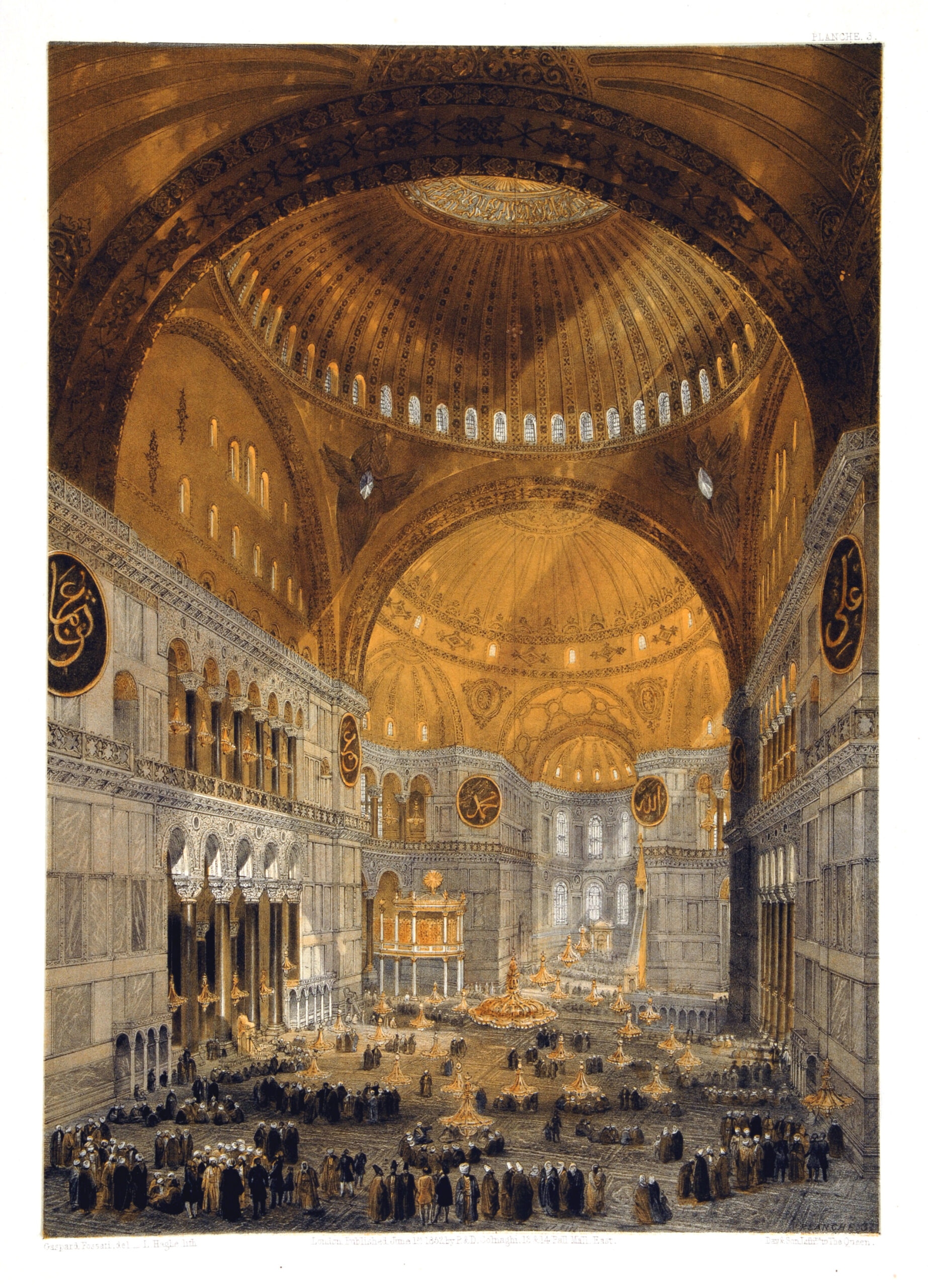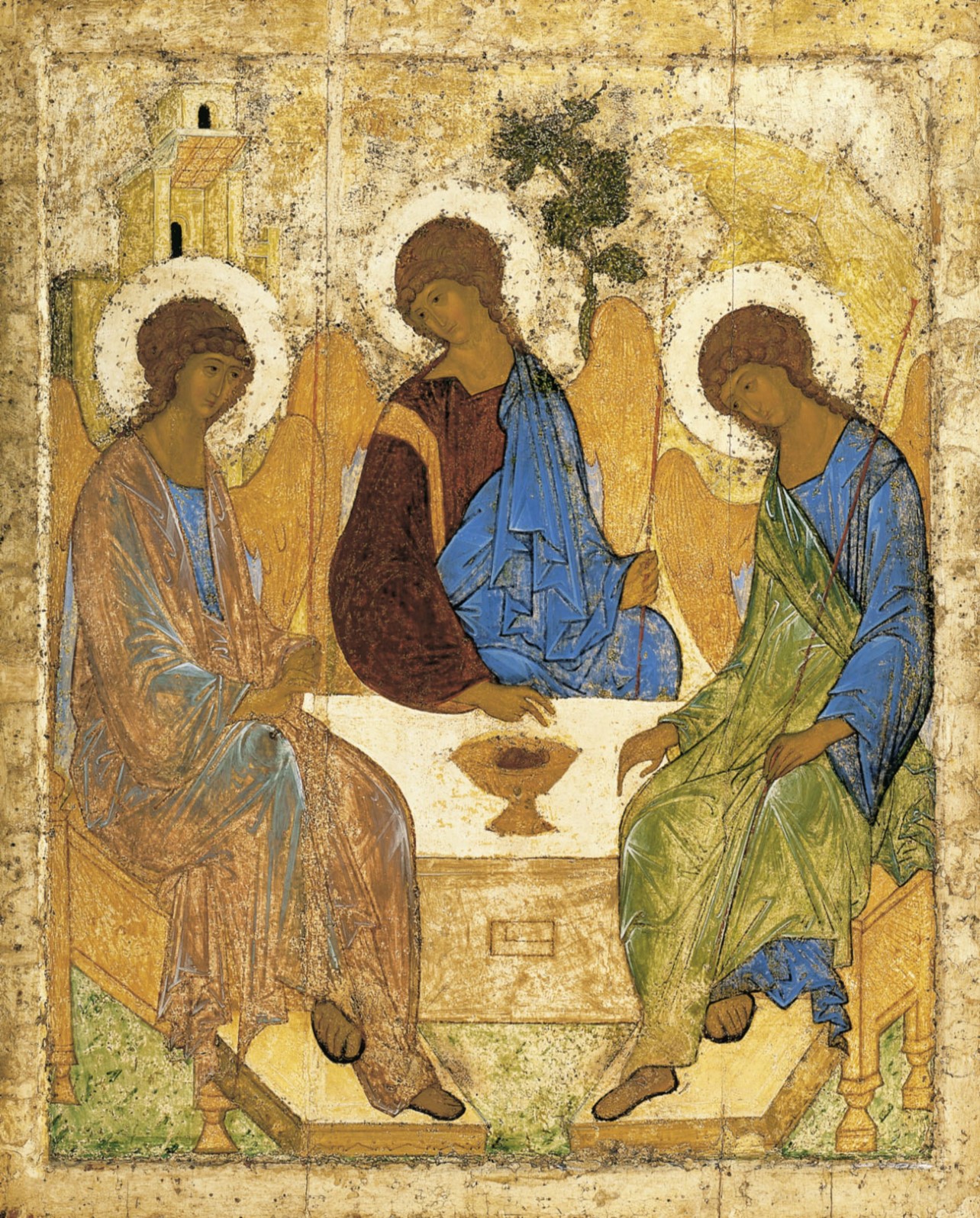Part 5 – Heaven on Earth
Above: Hagia Sophia, exterior (1852) by Gaspare Fossati*

Hagia Sophia, Istanbul, Turkey – interior (1852) by Gaspare Fossati.
“We knew not whether we were in heaven or on earth, for surely there is no such splendor or beauty anywhere upon earth. We cannot describe it to you. Only we know that God dwells there among men, and that their service surpasses the worship of all other places. We cannot forget that beauty.”
These are the epic words spoken by the ambassadors whom Prince Vladimir of Russia sent to survey the major religions of the world in order that one might be chosen to unify the people of pagan Russia. It is a most grand and lovely legend that when these emissaries arrived at Constantinople and stepped inside the magnificent cathedral, the Hagia Sophia (Church of Holy Wisdom), they were swept up in the beauty of worship being offered in this space. Having personally visited this incredible cathedral, it is not hard to see why such a story would be told. You feel as though you have been transported from earth to heaven.
It maybe isn’t exactly how Russia became Christian, but Vladimir did experience conversion and declared Christianity the religion of the nation around the year AD 988. Churches were built across the land as pagan idols were torn down. Vladimir changed his warring and violent ways seeking peace with neighboring nations, looking after the poor and building schools among his people. The result was a strong and unified country centered around newfound faith in God.
Read more on Prince Vladimir and Russia’s conversion>
*These two prints are from the drawings of Gaspare Fossati, a Swiss-speaking Italian architect, who along with his brother Giuseppe were appointed to restore the badly dilapidated Hagia Sophia mosque/cathedral. The work was done between 1847 and 1849 with a crew of more than 800 workers. These images appeared in a London album, Aya Sophia of Constantinople as Recently Restored by order of H.M. The Sultan Abdulmedjid (1852) Read more on the Hagia Sophia here> http://ayasofyamuzesi.gov.tr/en/history
A Portrait of Unity and Love

Hospitality of Abraham (between 1408-1425) by Andrei Rublev.
It is out of Russia’s heritage of faith that perhaps the world’s most well-known work of Christian art comes to us – Rublev’s Holy Trinity. Rublev was a Russian monk who devoted his life to the painting of icons and frescoes in and around Moscow, Russia. He painted this image in memory of Saint Sergius, the founder of Russia’s Monastery of the Holy Trinity. The painting was orignally hung over the tomb of Sanit Sergius, and now resides in the Tretyakov Gallery in Moscow.
Saint Sergius had a wonderful vision that all Rusia should be united around the Name of God. In this unity of faith and love, the Russian people would conquer “the devouring hatred of the world by the contemplation of the Holy Trinity.” *
The icon of the Holy Trinity is not actually a depiction of the Holy Trinity, but rather an illustration of the story of God’s appearance to Abraham in the form of three men. It’s true title is the Hospitality of Abraham. Rublev uses this image of the three guests to illustrate the Triune God.
The mysterious way in which these three figures are communing and interacting with each other and the similarities/differences in the figures portrays the Trinity concept of one God in three persons. Here is a circle of love (and for us, forgiveness). You can read it in their faces. Humility and grace are present also along with a profound peace. All three figures hold staffs in their left hands indicative of their authority and power. On the table sits a single bowl of food, also indicative of their oneness.
The Father, seated left, is dressed in a luminous, iridescent cloak as the Father cannot be seen and yet is visible in all creation. It would also seem a visual representation of Psalm 104:2 – “You robe yourself in light as in a garment.” With his right hand he gestures the sign of blessing toward the figure of Christ.
At center, sits Christ the Son. His garment is brown, to represent his human, earthly nature, with a blue cloak to represent his heavenly, divine nature. A band of gold across his shoulder, symbolizing government authority, signifies Christ’s kingship. His right hand gestures towards the chalice indicating his divine mission to become the sacrificial lamb who will take away the sins of the world. His gesture of two fingers again is a reference to his dual nature – fully man and fully God.
The Holy Spirit is seated at right wearing both blue and green, the colors of heaven and earth. It is the Spirit who moves through all – heaven, earth, water, sky. The green cloak is also representative of the new life and renewal in the Spirit as experienced by believers. The figure’s hand gestures downward, perhaps to the small opening at the front of the altar representative of the customary placement of relics and remains of saints by certain traditions. Henri Nouwen in his reflection on the Holy Trinity writes:
“We must give all our attention to that open space because it is the place to which the Spirit points and where we become included in the divine circle…I come to the realization that this rectangular space speaks about the narrow road leading to the house of God. It is the road of suffering. While it’s four corners remind us that it represents the created order, including all people from north, south, east and west, its position in the altar signifies that there is room around the divine table only for those who are willing to become participants in the divine sacrifice by offering their lives as a witness to the love of God.” *
As you view this work, may you be drawn into this place of fellowship with the triune God. May it be a place of comfort, renewal, strength, and peace – a house of love as Nouwen writes.
*Behold the Beauty of the Lord – Praying with Icons (1987) by Henry J.M. Nouwen
Looking for Jesus

Fresco with Abraham and his three visitors, Via Latina Catacomb, Rome (4th century).
It was a practice among early Christians to peruse the old Hebrew texts (our Old Testament) in search of signs and proofs of the Gospel story of Christ. One of the texts that seemed to give such assurance was the story of God visiting Abraham as three men:
“The Lord appeared to Abraham near the great trees of Mamre while he was sitting at the entrance to his tent in the heat of the day. Abraham looked up and saw three men standing nearby. When he saw them, he hurried from the entrance of his tent to meet them and bowed low to the ground.” Genesis 18:1-2
Early Christian historian, Eusebius (3rd-4th century), writes in his Proof of the Gospel, that this text speaks of a pre-incarnation appearance of Christ to Abraham. Eusebius then describes to his readers that he has seen the image that is displayed at the actual site of the visit – an image of three figures of which the central figure “[surpasses] the other two in glory.” The image was perhaps something similar to the one below of Abraham and his guests. The central figure in the top half is centered inside what is known as a mandorla (a visual indicator for Christ’s majesty, glory and divinity).

Mosaic with Abraham entertaining his three visitors Santa Maria Maggiore, Rome (AD 432-440).
This is one image that Christian artists would return to over and over again as the centuries passed, and quickly became a way to represent the God who was to be understood as three beings in one.
Anything But One
Lutherans
Calvinists
Baptists
Anabaptists
Methodists
Pentecostals
Mennonites
Hutterites
Amish
Quakers
Puritans
Pilgrims
Anglicans
Episcopalians
Adventists
Presbyterians
The results of the movement we’ve been following as started by Martin Luther was far from a unified effort. As soon as the door had been opened to individuals thinking freely and openly about faith in God, the unity was lost. Split after split after split. Each theologian taking a flock of followers for his own.
Not much seems to have changed since. Denominations which formed over issues such as baptizing infants or adults, dunking or sprinkling, total depravity or free-will, avoiding modern technology or embracing it, singing a cappella or with a pipe organ, continue to have splits today. It goes on and on and on. There is much talk in modern Protestant settings, as there was in early Protestant settings, about what we do or don’t believe. It is as difficult today as it was back then to see ourselves as ONE body, upheld by our common beliefs and practices. Instead we see many bodies, defined by how we believe differently. And does any one of us really know better than another? Nope.
The Cambridge English Dictionary defines “denomination” as: A religious group that has slightly different beliefs from other groups that share the same religion.
Slightly? Only slightly different? Yep, in the grand scheme of things, the differences we encounter from one denomination to another may be considered small. Many of these have little impact on the gospel’s main message and living it out on a daily basis. Individuals who truly love God and have received the gift of salvation are to be found in any and all denominations. Love God, love your neighbor…isn’t that how things were ultimately summed up by Jesus?
On Earth as It Is In Heaven
Christ himself prayed powerfully for his followers to be unified (it is a most grand and incredible vision – one that hardly seems possible in the splintered realm of Protestantism):
“My prayer is not for them alone. I pray also for those who will believe in me through their message, that all of them may be one, Father, just as you are in me and I am in you. May they also be in us so that the world may believe that you have sent me. I have given them the glory that you gave me, that they may be one as we are one – I in them and you in me – so that they may be brought to complete unity. Then the world will know that you sent me and have loved them even as you have loved me.” – John 17: 20-23
I find myself sometimes reflecting…How much time has been wasted contemplating earth’s division rather than contemplating heaven’s unity?
Final Thoughts
I would encourage you to think about getting out of whatever Protestant or other box you find yourself in. I belong to a Bible study with individuals from a variety of Protestant denominations. I cherish this group and our ability to lay our unique flavor of Christianity aside as we dig into the Scriptures every week. We really do find that we have far more in common than not, and THAT is what Martin Luther intended!
I also want to say, and you can probably guess by now…I truly believe that one of the ways forward for Christians, and especially Protestants, is to embrace our visual heritage – something that has been lost to us for 500 years. This is one heritage, it spans the centuries and the globe. To view artistic expressions of faith made by believers now or then gives me a sense of connection. I become aware of the “great cloud of witnesses” spoken of in Hebrews.
Christianity’s visual identity can teach us, revive us, and unify us.
Down an Ancient Path
The BIRCH TREE STUDIO BLOG
